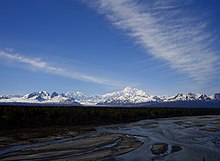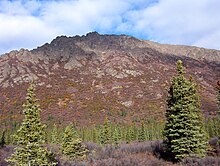Alaska Range
| Alaska Range | |
|---|---|
 Mount Hunter, Mount Huntington and other rugged peaks of the Alaska Range near Denali | |
| Highest point | |
| Peak | Denali |
| Elevation | 20,310 ft (6,190 m)[1][2] |
| Listing | List of mountain ranges |
| Coordinates | 63°04′10″N 151°00′27″W / 63.0695°N 151.0074°W[3] |
| Geography | |
| Country | United States |
| State | Alaska |
| Parent range | American Cordillera |
| Borders on | Pacific Coast Ranges |
The Alaska Range is a relatively narrow, 600-mile-long (950 km) mountain range in the southcentral region of the U.S. state of Alaska, from Lake Clark at its southwest end[4] to the White River in Canada's Yukon Territory in the southeast. Denali, the highest mountain in North America, is in the Alaska Range. The range is part of the American Cordillera.
The Alaska Range is one of the highest mountain ranges in the world, after the Himalayas and the Andes.
Description
[edit]

The range forms a generally east–west arc with its northernmost part in the center, and from there trending southwest towards the Alaska Peninsula and the Aleutian Islands, and trending southeast into British Columbia and the Pacific Coast Ranges. The mountains act as a high barrier to the flow of moist air from the Gulf of Alaska northwards, and thus have some of the harshest weather in the world. The heavy snowfall also contributes to a number of large glaciers, including the Cantwell, Castner, Black Rapids, Susitna, Yanert, Muldrow, Eldridge, Ruth, Tokositna, and Kahiltna Glaciers. Four major rivers cross the Alaska Range, including the Delta and Nenana Rivers in the center of the range and the Nabesna and Chisana Rivers to the east.

The range is part of the Pacific Ring of Fire, and the Denali Fault that runs along its southern edge is responsible for many major earthquakes. Mount Spurr is a stratovolcano located at the northeastern end of the Aleutian Volcanic Arc which has two vents, the summit and nearby Crater Peak.
Parts of the Alaska Range are protected within Wrangell-St. Elias National Park and Preserve, Denali National Park and Preserve, and Lake Clark National Park and Preserve. Several highways cross through the passes of the range: the George Parks Highway from Anchorage to Fairbanks via Windy Pass, the Richardson Highway from Valdez to Fairbanks via Isabel Pass, and the Tok Cut-Off from Gulkana Junction to Tok, Alaska via Mentasta Pass. The Alaska Pipeline parallels the Richardson Highway. A part of the Alaska Highway is situated on the northern slopes of the eastern section of the range.
History
[edit]The name "Alaskan Range" appears to have been first applied to these mountains in 1869 by naturalist W. H. Dall. The name eventually became "Alaska Range" through local use. In 1849 Constantin Grewingk applied the name "Tschigmit" to this mountain range. A map made by the United States General Land Office in 1869 calls the southwestern part of the Alaska Range the "Chigmit Mountains" and the northeastern part the "Beaver Mountains".[5] However, the Chigmit Mountains are now considered part of the Aleutian Range.
Starting in the mid 1880s to early 1900s, early non-native explorers traversed various sections of the Alaska Range. The first recorded expedition was in the Eastern Alaska Range led by H. T. Allen in 1885. His team went from Suslota Lake to Tetlin Lake and unto the Tanana River via Miles Pass.[6][7] He noted that it would be possible to build a road from Prince William Sound to the Yukon River.[8] Six years later, Frederick Schwatka and Charles W. Hayes crossed the extreme eastern end of the range via the White River and into the Copper River basin through Skolai Pass in what is now called Saint Elias Mountains. In 1898, W. C. Mendenhall and E. F. Glenn traversed Isabel Pass and were within 15–20 miles of the Tanana River before turning around.[6] Separately, that same year, Robert Muldrow and George Homans Eldridge crossed Broad Pass then Windy Pass into the Nenana River valley.[9]
Major peaks
[edit]
| Name | Elevation (ft/m) | |
|---|---|---|
| Denali | 20,310 | 6,190 |
| Mount Foraker | 17,400 | 5,300 |
| Mount Hunter | 14,573 | 4,442 |
| Mount Hayes | 13,832 | 4,216 |
| Mount Silverthrone | 13,218 | 4,029 |
| Mount Moffit | 13,020 | 3,970 |
| Mount Deborah | 12,339 | 3,761 |
| Mount Huntington | 12,240 | 3,730 |
| Mount Brooks | 11,890 | 3,620 |
| Mount Russell | 11,670 | 3,560 |
Subranges (from west to east)
[edit]
- Neacola Mountains[4]
- Revelation Mountains
- Teocalli Mountains
- Kichatna Mountains
- Central Alaska Range/Denali Massif
- Eastern Alaska Range/Hayes Range
- Delta Mountains
- Mentasta Mountains
- Nutzotin Mountains
Documented wilderness traverses of Alaska Range
[edit]
- Mentasta Lake to Kitchatna Mountains (1981): Scott Woolums, George Beilstein, Steve Eck, and Larry Coxen by skis: first traverse. 375 miles (604 km) in 45 days.[10]
- Canada to Lake Clark (1996): Roman Dial, Carl Tobin, and Paul Adkins by mountain bike and packraft: first full-length traverse. 775 miles (1,247 km) in 42 days.[11]
- Tok to Lake Clark (1996): Kevin Armstrong, Doug Woody, and Jeff Ottmers by snowshoe, foot, and packraft: first foot traverse. 620 miles (1,000 km) in 90 days.[12]
- Lake Clark to Mentasta Lake (2016): Gavin McClurg by paraglider and foot: first vol-biv (fly/camp) traverse. 466 miles (750 km) in 37 days.[13]
- Cantwell/Yakutat to Unimak Island (2020): Quoc Nguyen and Dan Binde by foot and packraft. 2,500 miles (4,000 km) in 120 days.[14]
See also
[edit]References
[edit]
- ^ Newell, Mark; Horner, Blaine (September 2, 2015). "New Elevation for Nation's Highest Peak" (Press release). USGS. Retrieved May 24, 2023.
- ^ "Topographic map of Denali". opentopomap.org. Retrieved 2023-05-24.
- ^ "Denali". Geographic Names Information System. United States Geological Survey, United States Department of the Interior. Retrieved 2023-05-24.
- ^ a b Sources differ as to the exact delineation of the Alaska Range. The Board on Geographic Names entry is inconsistent; part of it designates Iliamna Lake as the southwestern end, and part of the entry has the range ending at the Telaquana and Neacola Rivers. Other sources identify Lake Clark, in between those two, as the endpoint. This also means that the status of the Neacola Mountains is unclear: it is usually identified as the northernmost subrange of the Aleutian Range, but it could also be considered the southernmost part of the Alaska Range.
- ^ Name history from the Board on Geographic Names entry for the Alaska Range.
- ^ a b Fred H. Moffit (1954). Geology of the eastern part of the Alaska Range and adjacent area (PDF) (Report). US Department of the Interior, Geological Survey. Retrieved 17 May 2024.
- ^ Webb, Melody (1993). Yukon: The Last Frontier. University of Nebraska Press. pp. 106–109. ISBN 0-7748-0441-6.
- ^ Naske, Claus (June 1983). Alaska Road Commission Historical Narrative (PDF) (Report). State of Alaska Department of Transportation and Public Facilities.
- ^ Fred H. Moffit (1916). Broad Pass Region, Alaska (PDF) (Report). United States Geological Survey.
- ^ "Ski Traverse of the Whole Alaska Range". American Alpine Journal. 24: 137–138. 1982. Retrieved 2023-05-24.
- ^ "A Wild Ride". National Geographic Magazine. Vol. 191. 1997. pp. 118–131.
- ^ "Alaska Range Traverse". American Alpine Journal. 39: 169–170. 1997. Retrieved 2023-05-24.
- ^ Cross Country Magazine, Vol 171. Pages 52-52. Red Bull Media House Films "Under the Midnight Sun"
- ^ "Hikers Cover 2,500 Miles to Reach Southernmost Portion on Unimak Island" (PDF). Archived from the original (PDF) on 2022-05-31.
Further reading
[edit]- Churkin, M., Jr., and C. Carter. (1996). Stratigraphy, structure, and graptolites of an Ordovician and Silurian sequence in the Terra Cotta Mountains, Alaska Range, Alaska [U.S. Geological Survey Professional Paper 1555]. Washington, D.C.: U.S. Department of the Interior, U.S. Geological Survey.
- Alaska Range
- Landforms of Bethel Census Area, Alaska
- Landforms of Copper River Census Area, Alaska
- Landforms of Southeast Fairbanks Census Area, Alaska
- Landforms of Yukon–Koyukuk Census Area, Alaska
- Mountain ranges of Yukon
- Mountains of Denali Borough, Alaska
- Mountains of Kenai Peninsula Borough, Alaska
- Mountains of Lake and Peninsula Borough, Alaska
- Mountains of Matanuska-Susitna Borough, Alaska
- Mountains of Unorganized Borough, Alaska

